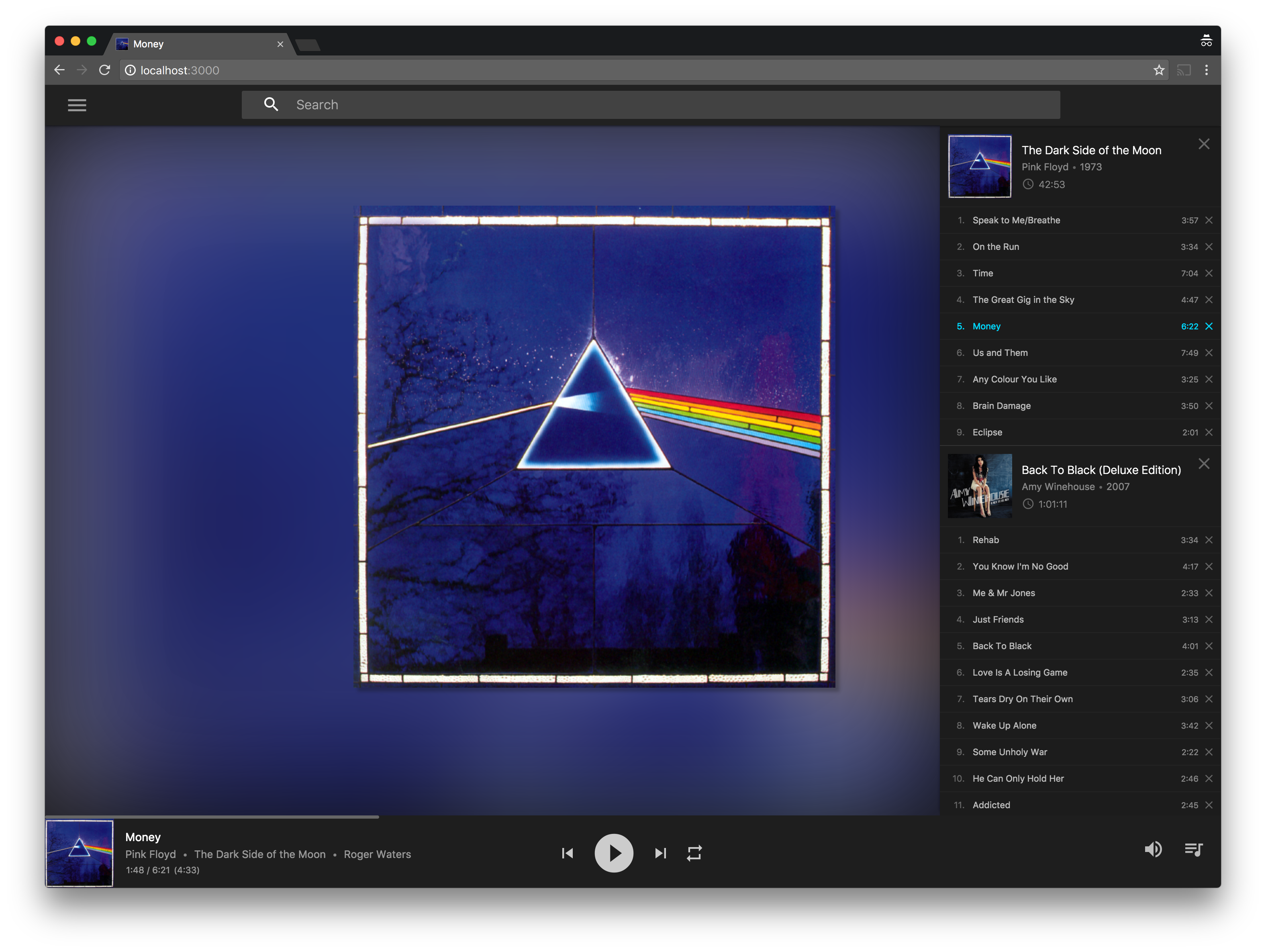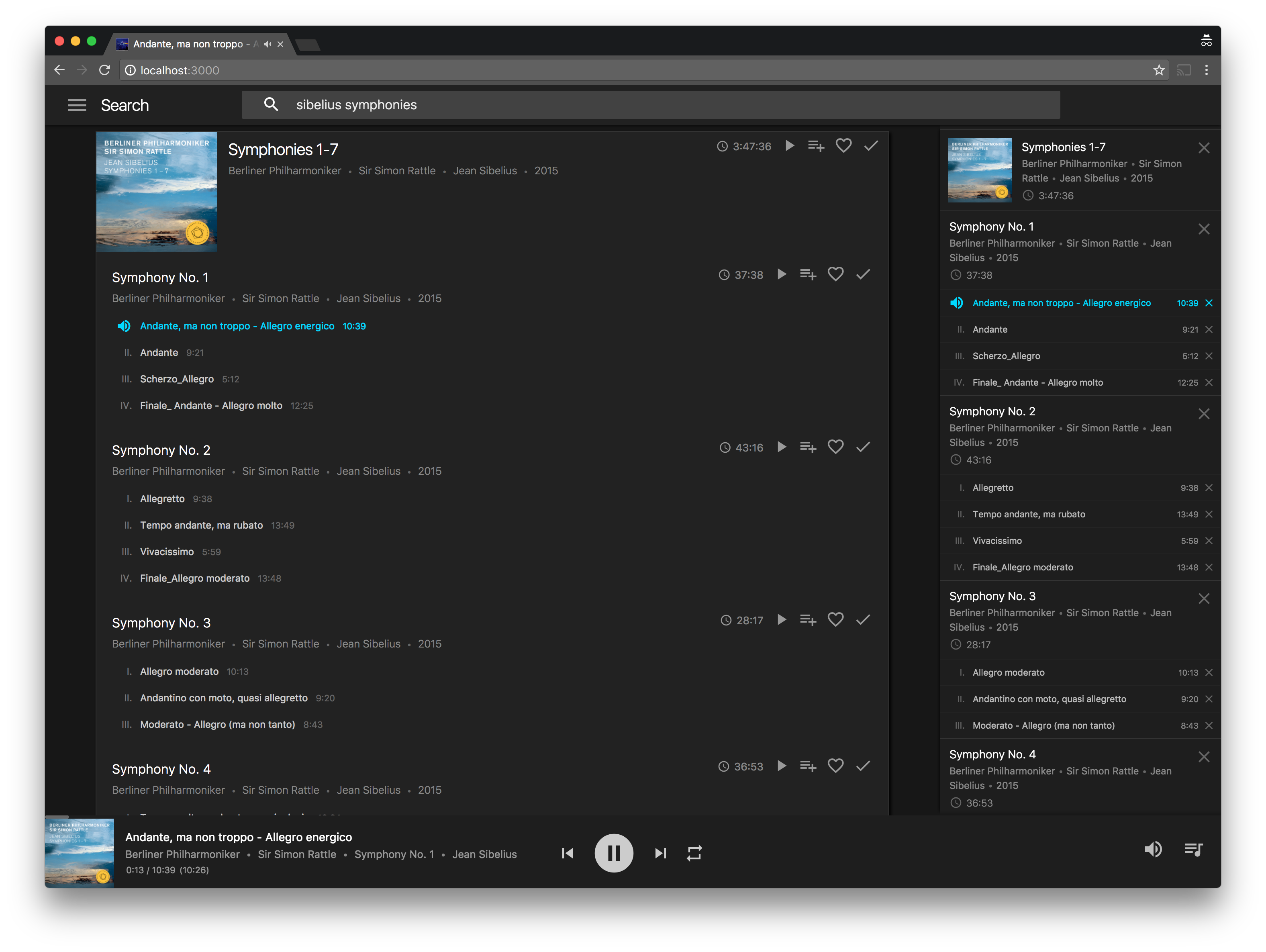Tchaik is an open source music organisation and streaming system. The backend is written in Go, the frontend is built using React, Flux and PostCSS.
- Automatic prefix grouping and enumeration detection (ideal for classical music: properly groups big works together).
- Multiplatform web-based UI and REST-like API for controlling player.
- Multiple storage and caching options: Amazon S3, Google Cloud Storage, local and remote file stores.
- Import music library from iTunes or build from directory-tree of audio tracks.
- Go 1.4+ (recent changes have only been tested on 1.5).
- NodeJS, NPM and Gulp installed globally (for building the UI).
- Recent version of Chrome (Firefox may also work, though hasn't been fully tested).
If you haven't setup Go before, you need to first set a GOPATH (see https://golang.org/doc/code.html#GOPATH).
To fetch and build the code for Tchaik:
$ go get tchaik.com/cmd/...
This will fetch the code and build the command line tools into $GOPATH/bin (assumed to be in your PATH already).
Building the UI:
$ cd $GOPATH/src/tchaik.com/cmd/tchaik/ui
$ npm install
$ gulp
Alternatively, if you want the JS and CSS to be recompiled and have the browser refreshed as you change the source files:
$ WS_URL="ws://localhost:8080/socket" gulp serve
Then browse to http://localhost:3000/ to use tchaik.
To start Tchaik you first need to move into the cmd/tchaik directory:
$ cd $GOPATH/src/tchaik.com/cmd/tchaik
The easiest way to begin is to build a Tchaik library on-the-fly and start the UI in one command:
$ tchaik -itlXML ~/path/to/iTunesLibrary.xml
You can also convert the iTunes Library into a Tchaik library using the tchimport tool:
$ tchimport -itlXML ~/path/to/iTunesLibrary.xml -out lib.tch
$ tchaik -lib lib.tch
NB: A Tchaik library will generally be smaller than its corresponding iTunes Library. Tchaik libraries are stored as gzipped-JSON (rather than Apple plist) and contain a subset of the metadata used by iTunes.
Alternatively you can build a Tchaik library on-the-fly from a directory-tree of audio files. Only files with supported metadata (see github.com/dhowden/tag) will be included in the index:
$ tchaik -path /all/my/music
To avoid rescanning your entire collection every time you restart, you can build a Tchaik library using the tchimport tool:
$ tchimport -path /all/my/music -out lib.tch
$ tchaik -lib lib.tch
A full list of command line options is available from the --help flag:
$ tchaik --help
Usage of tchaik:
-add-path-prefix prefix
add prefix to every path
-artwork-cache path
path to local artwork cache (content addressable)
-auth-password password
password to use for HTTP authentication
-auth-user user
user to use for HTTP authentication (set to enable)
-checklist file
checklist file (default "checklist.json")
-cursors file
cursors file (default "cursors.json")
-debug
print debugging information
-favourites file
favourites file (default "favourites.json")
-itlXML file
iTunes Library XML file
-lib file
Tchaik library file
-listen address
bind address for main HTTP server (default "localhost:8080")
-local-store path
path to local media store (prefixes all paths) (default "/")
-media-cache path
path to local media cache
-path directory
directory containing music files
-play-history file
play history file (default "history.json")
-playlists file
playlists file (default "playlists.json")
-remote-store address
address for remote media store: tchstore server <host>:<port>, s3://<region>:<bucket>/path/to/root for S3, or gs://<bucket>/path/to/root for Google Cloud Storage
-tls-cert file
certificate file, must also specify -tls-key
-tls-key file
certificate key file, must also specify -tls-cert
-trace-listen address
bind address for trace HTTP server
-trim-path-prefix prefix
remove prefix from every path
-ui-dir directory
UI asset directory (default "ui")
Set -local-store to the local path that contains your media files. You can use trim-path-prefix and add-path-prefix to rewrite paths used in the Tchaik library so that file locations can still be correctly resolved.
Set -remote-store to the URI of a running tchstore server (hostname:port). Instead, S3 paths can be used: s3://<region>:<bucket>/path/to/root (set the environment variables AWS_ACCESS_KEY_ID and AWS_SECRET_ACCESS_KEY to pass credentials to the S3 client), or Google Cloud Storage paths: gs://<bucket>/path/to/root (set environment variable GOOGLE_APPLICATION_CREDENTIALS to point to the JSON credentials file).
Set -media-cache to cache all files loaded from -remote-store (or -local-store if set).
Set -artwork-cache to create/use a content addressable filesystem for track artwork. An index file will be created in the path on first use. The folder should initially be empty to ensure that no other files interfere with the system.
Set -trace-listen to a suitable bind address (i.e. localhost:4040) to start an HTTP server which defines the /debug/requests endpoint used to inspect server requests. Currently we only support tracing for media (track/artwork/icon) requests. See https://godoc.org/golang.org/x/net/trace for more details.
The default value for parameter -local-store is / which does not work on Windows. When all library music is organised under a common path you can set -local-store and -trim-path-prefix to get around this (for instance -local-store C:\Path\To\Music -trim-path-prefix C:\Path\To\Music).
Development is on-going and the codebase is changing very quickly. If you're interested in contributing then it's safest to jump into our gitter room and chat to people before getting started!

